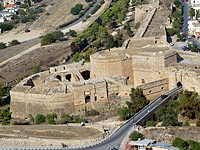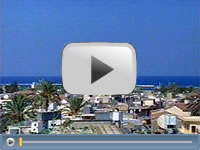
The Ravelin (Land Gate) in Famagusta, North Cyprus.
 |
the north cyprus travel guide |
 |
|
The Ravelin (Land Gate)
When the Ottomans laid siege to the walled city of Famagusta in North Cyprus, there were only two ways in, the Sea Gate and the Land Gate. The Land Gate was protected by the Rivettina Bastion, or Ravelin, and this impressive tower was not going to topple easily. The Land Gate was the original entrance to the medieval city of Famagusta, which the Venetians remodeled to suit artillery fire and cannon. Protected by a double moat, there was no way into Famagusta's walled city except over the wooden drawbridge. (Entry to the city was originally via a cannon emplacement at the side of the gate.) The Ravelin under siege at Famagusta, Northern CyprusAfter weeks of battling and digging under the walls during June 1571, the Ottoman Turks finally managed to gain access to the walls of the Ravelin. The Venetians, determined to hold fast, blew up their own secret tunnel under the walls, burying a thousand Ottoman soldiers in the rubble, not to mention one hundred of their own men. Although this destruction halted the enemy advance for a while, the Venetians defending Famagusta were quick to built more barricades behind the fallen tower, using sandbags and earth-filled carts. However, by 1 August, the Venetians surrendered, weakened by hunger, fatigue and plague. The surrendering citizens waved a white flag from the top of the tower, so the victorious ottomans named it the "Akkule" (from the Turkish, "Ak" meaning white and "Kule" meaning bastion) or "White Tower".
The Ravelin today at Famagusta, North CyprusToday, the Ravelin houses the Tourist Information office for Famagusta, and next to it, the sloping ramp to the walls originally used to wheel in the cannons. The stone bridge seen today over the main moat was built in the 19th century, although its elegant arches seem almost insubstantial next to the vast walls. You can still see the grooves above the gateway into the city that guided the chains of the portcullis and drawbridge. Inside, the Ravelin is a labyrinth of guard houses and rooms, converted into the Akkule ören Yeri attraction. It takes a full fifteen minutes to wind through the Ravelin's complex of rooms, ramps, steps and dungeons. Look up and you can still see the holes where the acrid smoke from cannon fire escaped. The recesses in the walls were used for storing gunpowder barrels and cannon balls. Despite artillery and cannon being relatively new technology, those used by both the Venetians and the Ottomans during the siege were the most powerful in existence at the time. Cannons and Gunpowder at the Ravelin, North CyprusLittle more than large iron tubes on wheels, these cannons fired iron or stone cannon balls, which were simply dropped into the cannon mouth. The gunpowder would be ignited with a red hot poker, and the resulting explosion would fill the room with choking smoke. Furthermore, iron was so expensive, that the Venetians soldiers would creep out from the city at night to retrieve any cannon balls within reach, ready to reuse the next day! It is humbling to stand in this tower and realise that as little as 5,000 Venetians managed to hold back over 100,000 Ottoman Turks for eight months during the siege, before finally accepting that disease and hunger would cut them down before the Turks would ever reach them. |
|
North Cyprus quick: holidays | flights | hotels | property | kyrenia | famagusta | photos | map | weather | history | news
All text is copyrighted by Cyprus44. Photographs are copyrighted by their respective photographers.
For more information read our copyright policy, privacy policy and disclaimer.
This web page is served on 18 September 2025 at 7:49:07 PM.
![]()
Cyprus44 in other languages: Nordzypern | Chypre Nord | Severní Kypr | Северный Кипр
partner sites: goNorthCyprus Travel | Pacific Rent-A-Car | Amy Holiday Villas | other partner sites









